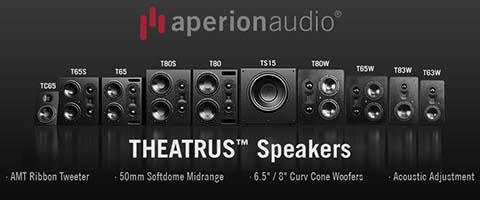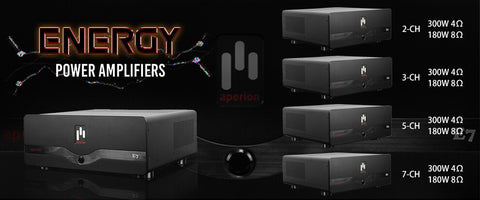By Caleb Denison-Home Theater Guru
- - - - - - - - - - - - - - - - - - - - - - - - - - - - - - - - - - - - - - - - - - - - - - - - - - - - - - - - - - - - - - - -
While doing research on home theater you’ve no doubt run into these numbers. This isn’t secret code designed to confuse you. It’s actually pretty simple stuff – but it’s important for you to know what they mean and, equally important, which configuration best suits your needs. In this course, we’ll discuss the differences between these speaker systems and surround options, the role of the speakers in the system and how the surround channels are configured.

- - - - - - - - - - - - - - - - - - - - - - - - - - - - - - - - - - - - - - - - - - - - - - - - - - - - - - - - - - - - - - - -
What is 5.1?
Let’s begin with the basics. 5.1 refers to five speaker channels and one subwoofer channel (.1) Depending on the size of the speakers in your system, the subwoofer may handle only the extremely low frequency effects (A.K.A. LFE) It may also handle bass that might otherwise be sent to the front and center speakers.
The rest of your 5.1 speaker system is comprised of front left and right speakers, a dedicated center channel and two side surround speakers. Both the terms and physical location of your surround speakers are important — more on that in a moment.
In both Dolby Digital and DTS surround modes, the speaker that does all of the heavy lifting in your home theater is your center channel. The center channel reproduces the on-screen dialogue and many sound effects. In fact, the majority of the sound on your DVDs comes right out of the center channel! Since it reproduces the dialogue for what you see on your screen, it is typically placed above or below the video display.
Your front left and right speakers tend to handle the musical score and a great deal of effects. You want them to be symmetrically placed to the left and right of your video display.
The side surround speakers are the main set of surround speakers and fill out your standard 5.1 system. These speakers should be placed to the sides of the listening position or just slightly behind. It is a common misconception that your surround speakers should be behind you.

- - - - - - - - - - - - - - - - - - - - - - - - - - - - - - - - - - - - - - - - - - - - - - - - - - - - - - - - - - - - - - - -
6.1 and 7.1 Systems
6.1 and 7.1 systems add some more speakers into the mix. These are one or two rear surround speakers, and should be placed behind the listener. These speakers add spatial depth to movie soundtracks. Often, audio mixers at the film studios will use these channels to convey the sensation that something is heading at you from behind or disappearing well behind you. The flying arrows in the opening battle scene of “Gladiator” are a good example of this.
You might be surprised to learn, and what most salespeople at “Best Guys City” won’t tell you, is that though you may have or be interested in a 7.1 receiver, you may not necessarily need a 7.1 speaker system. Imagine that!
5.1 is still considered the surround sound standard (say that five times fast.) If you raid your DVD collection and look on the back of the cases, you’ll notice that 90% of your DVDs say “Dolby Digital 5.1”. That means that there is specific (or discrete) information for each speaker in your 5.1 system. This is where we start to notice a disconnect between the surround information on a DVD and how many speakers you need in a 6.1 or 7.1 system. If you have a 5.1 DVD but a full 7.1 system, what are your rear surrounds going to do? Don’t worry, they won’t be taking any naps. Typically they re-use the surround information from the side surrounds. With a smaller, properly set up home theater, you may not be able to hear the difference. However, if you have a large room, this effect can be impressive.
There are some bigger budget movies (e.g. Star Wars, The Lord of the Rings) that offer 6.1 surround when they make it to DVD. In these cases, there is information on the disc for one rear surround speaker. If you have two rear surround speakers (a 7.1 system) they both play the same soundtrack.
If you’d like to look for movies with 6.1 surround sound, it’s typically called Dolby Digital Surround EX or DTS ES and is found on the backs of DVD cases.
- - - - - - - - - - - - - - - - - - - - - - - - - - - - - - - - - - - - - - - - - - - - - - - - - - - - - - - - - - - - - - - -
Don’t count 7.1 out
As this article is being written, 7.1 source material is brand spankin’ new. 7.1 surround sound requires more space than a standard DVD can accommodate. For this reason, we will only see 7.1 surround sound on HD-DVD and Blu-Ray discs (or whichever one “wins” the annoying format war.) There are no 7.1 DVDs, but the capability is there with new DVD formats and one ought to keep this in mind when “future proofing” their Home Theater.
- - - - - - - - - - - - - - - - - - - - - - - - - - - - - - - - - - - - - - - - - - - - - - - - - - - - - - - - - - - - - - - -
Some Helpful Hints
- If your room is 15X20 or larger and you have room for two speakers in the back of the room, a 7.1 system makes the surround effect much more impressive, even if most of your DVDs are 5.1.
- If you have less than 3 feet behind your sitting position before hitting a wall, then you might be throwing money into the void on 6.1 or 7.1 rear surround speakers. It helps to have some actual depth to the room in order to take advantage of 6.1 and 7.1 soundtracks.
- If you have a narrow room, you may not need two rear surround speakers. Rooms that are 15 feet wide or less can be served well by one rear surround speaker (a 6.1 system.) A word to the wise, though — with the growing popularity of HD-DVD and Blu-Ray, you may want to have both rear surround speakers in place to take advantage of 7.1 down the road.
- If you use dipolar surround speakers in the side surround position, you may not need rear surround speakers right away. Dipolar surround speakers reflect enough sound off of the back wall that adding rear surround speakers may not add much to your experience until 7.1 movies are more readily available. Consider this an upgrade project for the future if you like.
- - - - - - - - - - - - - - - - - - - - - - - - - - - - - - - - - - - - - - - - - - - - - - - - - - - - - - - - - - - - - - - -
In Conclusion
You’ve been endowed and empowered with the information you need to make a ‘sound’ decision (yeah… I went there.) I hope this course sheds some light on an oft misunderstood subject. The great news here is, no matter what your choice, your new system will sound fantastic.

Complete Your Sound System Solution

Sign up for our newsletter below, and join our social media groups to stay up to date with the latest news and information from Aperion Audio!
 |
 |






 https://www.aperionaudio.com
https://www.aperionaudio.com